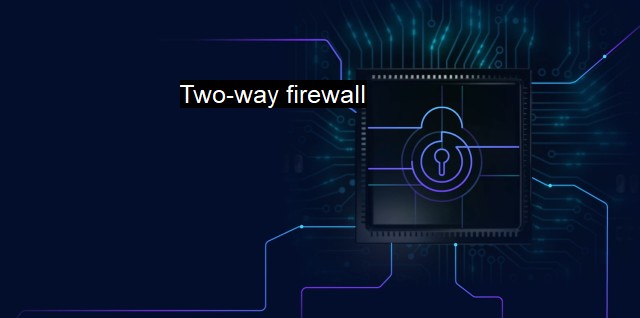What is Two-way firewall?
Exploring the Importance of a Two-Way Firewall in Cybersecurity and Antivirus Software: Protecting Your Network Inside Out
The concept of "Two-way Firewall" is a comprehensive part of cybersecurity algorithms and antivirus mechanisms. Its integration transforms the security level of a network or a device, providing a protective shield against unauthorized access and unidentified traffic.A firewall acts as a barrier or shield between a network and the internet. Using predetermined security rules, a firewall monitors and filters inbound and outbound traffic to help protect a network or device from malicious software or unauthorized access. Primarily, firewalls were designed to function as one-way gates. They only had the responsibility of stopping incoming traffic from the internet that was identified as potentially dangerous. With time, the nature of cyber threats evolved, giving birth to more sophisticated hacking methods. An analogy could be seen to traditional physical security, where just locking the doors might not necessarily keep the thieves out, especially if a window is open.
This gave rise to a stronger firewall concept - the “Two-way Firewall” - intended to provide advanced and robust security. Two-way firewalls, true to their name, provide double-directional network gateways to thoroughly screen both incoming and outgoing traffic. They are equipped with the standard inbound firewall protection and an added level of outbound firewall protection. Inbound protection ensures the network or system is safeguarded from external attacks like hacking attempts, phishing, or distributing malware. On the other hand, outbound firewall protection watches the network's outgoing traffic, essentially monitoring and controlling all data sent from your system to the outside world.
For instance, some threats penetrate the defensive shield of a network, masquerading as credible programs that you might install willingly. Once installed, such programs attempt to send information outwards: sensitive data going to unknown destinations, or computers turned into 'zombies' to participate in Distributed Denial of Service (DDoS) attacks. At this juniquidirectional monitoring less practical. It also becomes evident the integral role two-way firewalls can play in preventing both unauthorized data extraction and in thwarting attempts to use your system to harm others.
Two-way firewalls are implemented primarily using two forms of technology: packet filtering and stateful inspection. Packet filtering breaks down packets into components, assessing each individually against established security protocols. Stateful inspection, by contrast, expedites the filtering process by tracking network connections, documenting, and storing the data. Firewall rules are then applied based on secured connection type rather than per packet.
From a user’s perspective, the two-way firewall concept incorporated into antivirus software potentially increases security and data control. Beside identifying and eradicating viruses, two-way firewall enabled antivirus solutions monitor programs for abnormal behavior, block unauthorized broadcasts, and manage your device’s network connections in real-time.
Despite advancing cybersecurity, two-way firewalls are not without flaws. False positives may occur when legitimate traffic is inaccurately identified as threats. Firewalls may also struggle with encrypted data or applications that piggyback on approved traffic. Constant software updating is necessary to keep pace with evolving threat landscapes.
All in all, the "Two-way Firewall" concept represents a significant stride in cybersecurity with its double-barreled data protection approach. As technology and cyber threats continue to evolve, its mechanism and effective—which surely impacts positively on protecting digital material—is critical in fortifying network security.

Two-way firewall FAQs
What is a two-way firewall?
A two-way firewall is a security solution that monitors both incoming and outgoing traffic from a network. It acts as a barrier between the internet and your computer, preventing unauthorized access to your system, and also, allows your computer to send and receive data safely.How does a two-way firewall work?
A two-way firewall works by filtering incoming and outgoing traffic. It analyses the data packets that are trying to enter or leave the network and checks them against a set of rules to determine if they are safe. If the data packet meets the rules, it is allowed to pass, but if it's malicious, the firewall blocks it.Why do I need a two-way firewall?
A two-way firewall is essential for protecting your computer from cyber attacks. It helps to prevent hackers from gaining access to your system, stealing your personal information, or corrupting your data. It also blocks viruses and malware from being transmitted to your computer.What are the benefits of using a two-way firewall?
The benefits of using a two-way firewall include: preventing unauthorized access and data theft, protecting your computer from malware and virus attacks, blocking unwanted traffic, and giving you control over incoming and outgoing traffic. It provides an added layer of security to your network and gives you peace of mind that your data is safe.| | A | | | B | | | C | | | D | | | E | | | F | | | G | | | H | | | I | | | J | | | K | | | L | | | M | |
| | N | | | O | | | P | | | Q | | | R | | | S | | | T | | | U | | | V | | | W | | | X | | | Y | | | Z | |
| | 1 | | | 2 | | | 3 | | | 4 | | | 7 | | | 8 | | |||||||